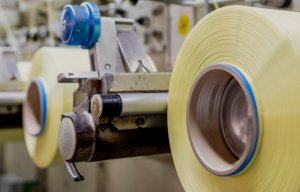
Circular success with Twaron
Teijin Techno Products, one of the core companies of the Teijin Group’s aramid fibres business, announced today the development of a groundbreaking fire fighting suit that it says offers the world’s highest levels of heat-barrier performance and comfortable, lightweight design. Developed in cooperation with Akao Co., Ltd., Japan’s leading manufacturer of fire fighting apparel, the suit is made with TripProtech aramid fibre fabric newly developed by Teijin Techno Pr
5th October 2010
Innovation in Textiles
|
Tokyo
Teijin Techno Products, one of the core companies of the Teijin Group’s aramid fibres business, announced today the development of a groundbreaking fire fighting suit that it says offers the world’s highest levels of heat-barrier performance and comfortable, lightweight design.
Developed in cooperation with Akao Co., Ltd., Japan’s leading manufacturer of fire fighting apparel, the suit is made with TripProtech aramid fibre fabric newly developed by Teijin Techno Products. Akao will begin selling the suit in early March of next year.
According to Teijin Techno, the new suit weighs just 2.5kg, or 10% lighter, and is 60% more effective in preventing second- and third-degree burns compared to the lightest suit previously developed by Teijin and Akao.
Generally speaking, the company says, the weight of a fire fighting suit, which is typically around 3kg, can be lowered by reducing fabric thickness; however, this can undermine both durability and flame and heat-barrier properties. “Until now, it had been a technical challenge to design a lightweight fire fighting suit that also offers high-level heat-barrier performance. As such, the new suit represents a major breakthrough by combining both features on such high levels for the first time,” Teijin Techno says.
The Triprotech fabric consists of three layers. The outermost layer, GBarrier Light, is made with Teijin’s Conex flame and heat-resistant meta-aramid fibre. Blending Technora high-strength para-aramid fibre in an optimum ratio has resulted in a thinner, lighter-weight design while maintaining fabric strength.
Teijin Techno Products also used proprietary technology to develop a unique, corrugated-weave structure that creates a highly efficient air layer in the innermost layer, or lining, called Tecwave. The air layer insulates heat and slows down heat conduction for significantly improved heat-barrier performance, also backed by the unique double-weave structure in the outermost layer.
The company says it also improved the weave pattern on the Tecwave layer’s inner surface that comes into contact with the fire fighter’s undergarments. By reducing friction and improving sliding performance, the fabric enables easier dressing than conventional suits so fire fighters can begin working as quickly as possible.
Teijin Techno Products, which commands more than 60% of the Japanese market for fire fighting suits, envisions sales of 100 million yen for its Tripprotech for use in the new fire fighting suit in the first year. Going forward, the company also plans to expand its business into overseas markets, including emerging countries such as India, Russia and Brazil, as well as developed countries in Europe, where the comfort of fire fighting suits is highly valued.
A spokesperson for Teijin Techno Products explains the background to the development of TripProtech: “Fire fighting suits not only must be flame retardant; they also must provide a heat barrier to minimize burns. Teijin Techno Products and Akao have a proven record of developing and selling fire fighting suits with aramid fibre fabrics for superior heat-barrier performance.”
“In the past, fire fighters typically fought fires from the outside of buildings, but the spread of high-rise apartment buildings and reinforced concrete houses has forced them to enter buildings and often get extremely close to the fire source in order to extinguish the fire. As a result, the severity and the degree of risk in fire fighting are both increasing. Furthermore, Japan’s fire fighting force is growing older.”
“There is an increasing need for more comfortable fire fighting suits that promote maximum freedom of movement and reduced fatigue. While fire fighting suits generally are not very heavy, weighing about 3kg compared to about 15-20kg of total equipment, improved comfort can have a significant impact on the fire-fighter by helping to reduce their fatigue.”

Business intelligence for the fibre, textiles and apparel industries: technologies, innovations, markets, investments, trade policy, sourcing, strategy...
Find out more